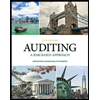
(1)
Internal Control: Internal control refers to the policies, and plans of the business organization along with other measures with a view to safeguard its assets, encourage the employees to adhere to the plans, to improve on the operational efficiency, and to ensure correct and reliable accounting information. Internal control is a process which ensures continuous reliability of accomplishment of a company’s objectives, related to operations, financial reporting, and in conformity with laws and regulations.
To describe: The five elements of internal control.
(1)
Explanation of Solution
Five elements of internal control:
- Control Environment: Control Environment refers to the attitude of top brass of the company or the corporate culture. The top brass of the company must set the tone to improve the morale for rest of the employees of the business.
- Risk assessment: The business must be able identify the risk associated with it, and accordingly use the internal control to safeguard its assets and ensures fairness in presentation in accounting information.
- Control procedures: The objective of setting the control procedure is to ensure that the business achieves its objectives.
- Monitoring controls: The internal control used in the business is being monitored by the internal auditors who are hired by the business, to ensure that the employees are adhering to the policies of the business and running the operations efficiently. The external auditors on the other hand ensures that the business accounting records are being maintained in accordance with the Generally Accepted Accounting Principles (GAAP).
- Information and communication: Information and communication system is important for a business and hence only authorized persons should be allowed the access to the confidential accounting information. Approvals are also should be made mandatory for the transactions by the
control system.
2.
The importance of internal control.
2.
Explanation of Solution
When the elements of internal control are considered, one element of internal control is not important than other. In order to have an effective internal control, all five elements are considered to be necessary.
Want to see more full solutions like this?
Chapter 7 Solutions
CENGAGENOW FOR CORP. FINC
- I am searching for the accurate solution to this general accounting problem with the right approach.arrow_forwardPlease provide the correct answer to this general accounting problem using valid calculations.arrow_forwardCan you solve this general accounting problem using appropriate accounting principles?arrow_forward
- Sarah is the president and general manager of the operation. Sarah has been very proactive in growing the business. She has met with her banker to discuss expanding the facilities and equipment with another $150,000 loan. Their first loan for $150,000 was secured by the industrial-size food production equipment purchased with the loan. The banker now demands an audit of the corporate financial statements before releasing another loan to the company. Sarah has offered to place the corporate account receivables up as collateral to secure the second loan. Based on revenue projections by her sister Jillian's sales team, Sarah believes that the company will not have trouble paying down the loan in a short period of time. Kim's assistant, Henry, monitors the production and shipment of Smackey Dog Food's regular line of products. Henry takes pride in his work and is involved in every facet of the operation. With only one other warehouse employee to help, Henry personally is involved in…arrow_forwardI need assistance with this financial accounting problem using appropriate calculation techniques.arrow_forwardDodge Industries has the following data: direct labor $185,000, direct materials used $210,000, total manufacturing overhead $195,000, and beginning work in process $45,000. Compute total manufacturing costs and total cost of work in process.arrow_forward
- I am looking for the most effective method for solving this financial accounting problem.arrow_forwardTreadway Equipment acquired manufacturing machinery at the beginning of the year at a cost of $86,000. The machinery has an estimated residual value of $5,500 and an estimated useful life of 5 years. Determine the second-year depreciation using the straight-line method.arrow_forwardHow can I solve this financial accounting problem using the appropriate financial process?arrow_forward
 Cornerstones of Financial AccountingAccountingISBN:9781337690881Author:Jay Rich, Jeff JonesPublisher:Cengage LearningPrinciples of Accounting Volume 1AccountingISBN:9781947172685Author:OpenStaxPublisher:OpenStax College
Cornerstones of Financial AccountingAccountingISBN:9781337690881Author:Jay Rich, Jeff JonesPublisher:Cengage LearningPrinciples of Accounting Volume 1AccountingISBN:9781947172685Author:OpenStaxPublisher:OpenStax College Auditing: A Risk Based-Approach (MindTap Course L...AccountingISBN:9781337619455Author:Karla M Johnstone, Audrey A. Gramling, Larry E. RittenbergPublisher:Cengage Learning
Auditing: A Risk Based-Approach (MindTap Course L...AccountingISBN:9781337619455Author:Karla M Johnstone, Audrey A. Gramling, Larry E. RittenbergPublisher:Cengage Learning


